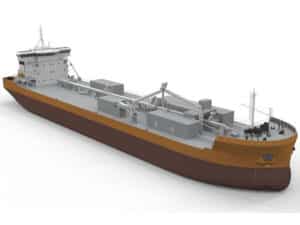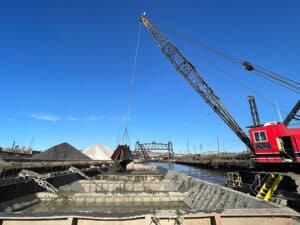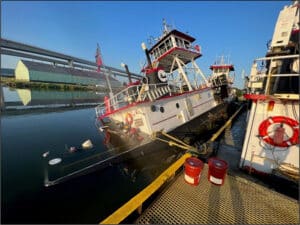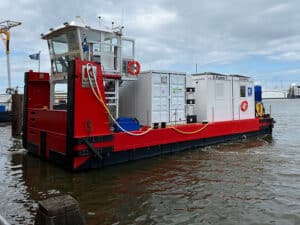
Ground breaking ceremony kicks off Upper Ohio Navigation Project
Written by Marine Log Staff
Austin Davis, the Lieutenant Governor of Pennsylvania; Col. Nicholas Melin, the commander of the U.S. Army Corp of Engineers Pittsburgh; U.S. Sen. Bob Casey of Pennsylvania; Jaime A. Pinkham, the Principal Deputy Assistant Secretary of the Army for Civil Works; Mitch Landrieu, Senior Advisor to the President and White House for Infrastructure; Mary Ann Bucci, the executive director of the Port of Pittsburgh Commission; and Mark Gentile, the president of Trumbull Corps; participated in a groundbreaking ceremony at Montgomery Locks and Dam in Monaca, Pennsylvania, Aug. 11, 2023. [U.S. Army Corps of Engineers Pittsburgh District photo by Michel Sauret]
Setting the stage for updating the Ohio River’s oldest navigation system, the Pittsburgh Engineer District welcomed industry, community and political leaders to an August 11 groundbreaking ceremony at the Montgomery Locks and Dam that officially marked the start of a construction of the Upper Ohio Navigation Project.
The multi-billion-dollar construction project will replace locks at the Emsworth, Dashields, and Montgomery locks and dams. The project will replace the auxiliary chambers, measuring 56 feet wide by 360 feet long, with locks measuring 110 feet wide by 600 feet long.
“You’ve probably noticed driving on site today. Construction is already underway,” said Col. Nicholas Melin, the commander of the Pittsburgh District. “It’s only fitting that we lift our shovels and take this step together continuing the tradition of great partnership.”
Col. Melin shoveled the dirt alongside U.S. Sen. Bob Casey of Pennsylvania; Austin Davis, the Lieutenant Governor of Pennsylvania; Mitch Landrieu, Senior Advisor to the President and White House for Infrastructure; Jaime A. Pinkham, the Principal Deputy Assistant Secretary of the Army for Civil Works; Mark Gentile, the president of Trumbull Corps; and Mary Ann Bucci, the executive director of the Port of Pittsburgh Commission.
“The Southwestern Pennsylvania economy couldn’t function without the Montgomery Locks and Dam. I worked to secure this investment from the infrastructure law so the Army Corps can upgrade the locks and dam to keep commerce flowing through our region,” Senator Casey said. “This is a celebration of a commitment of investment to a critically important project, not only for Beaver County, in southwestern Pennsylvania, and not only for our commonwealth, but for a significant region of the United States.”
Montgomery is part of the Upper Ohio navigation system, which sees 15 to 20 million tons of materials pass through its river chambers annually. The Upper Ohio Navigation Project is expected to support 28,800 jobs over its construction life, and 5,400 jobs annually after completion.
Overall, the Pittsburgh District operates 23 locks and dams on the Ohio, Monongahela, and Allegheny rivers, saving shippers and consumers approximately $4 billion in transportation costs compared to using other means such as trucks or rail.
“Our inland waterways are a critical artery sustaining the nation’s economy and families by delivering goods to our homes, connecting us to global markets, and bolstering employment. The investments we are making today will reinvigorate navigation and make it resilient to provide significant benefits for years to come,” Pinkham said.
The Corps of Engineers started constructing Montgomery Locks and Dam in 1932 and finished in 1936. The auxiliary lock has reached the end of its operational lifespan and is experiencing structural aging.
“What makes this project critical is the potential for structural failure of the lock walls, which would cause major interruption to river transportation,” said Chris Dening, the project manager for the construction of the Upper Ohio project. “Many of the walls have significant cracking along and across their lengths. We have observed leaking within the lock walls during operation, which confirmed the seriousness of the situation.”
If one of the lock walls failed, it would impact operations for several months. An unexpected failure would cause shippers to scramble to find new ways to reroute shipments at the last minute.
“The upgrades we are making at Montgomery Locks and Dam are just the first of three major investments to modernize the upper Ohio River navigation system,” said Steve Fritz, the Mega Project program manager for the Pittsburgh District. “We are building larger, newer, better locks that will provide a resilient navigation system in the Pittsburgh region for the next 100 years.”
Pending completion of the project,, the Pittsburgh District has taken several measures to address structural issues to avoid sudden failures. Pittsburgh’s engineers increased the frequency of their inspections at Montgomery and developed contingency plans for any potential emergency.
The Upper Ohio Navigation project includes three locks: Emsworth, Dashields, and Montgomery, the first three on the Ohio River downstream from Pittsburgh.
The Bipartisan Infrastructure Law provided $857 million for Montgomery construction and $77 million for Emsworth in 2022.
The 2022 funding places the Ohio River as the second-largest funded infrastructure project within the U.S. Army Corps of Engineers.
Montgomery is the first facilityon the Upper Ohio system to receive a larger 600-foot-long by 110-foot-wide lock chamber. District engineers plan to replace the smaller auxiliary chamber at all three facilities.
The average age of the three Upper Ohio facilities is 96 years old, with aging conditions that could lead to major navigation shutdowns. The auxiliary chambers at the three facilities are the smallest on the Ohio River, causing bottlenecks and slowdowns during maintenance periods, proving too small for today’s commercial barges.
The Pittsburgh District has already completed project phases to prepare for the upcoming chamber construction. The plan includes removing the auxiliary chamber to expand the lock size, which will cut into the gated dam currently on the river.
The next phase will bring a batch plant on site, allowing engineers to mix and pour concrete in place much faster than cement trucks. The new lock at Montgomery will require about 400,000 cubic yards of concrete, equivalent to a football field covered nearly 200 feet high, or 1.6 billion tons. The plant will produce nine different concrete mixes used in various types of construction, such as underwater, structural, and mass concrete, among others. An onsite laboratory will sample and test the concrete to ensure quality.




